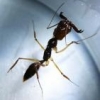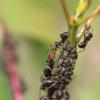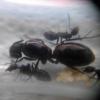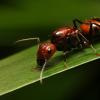1. Location of collection: Parking lot, IIT Bombay, Mumbai-India
2. Date of collection: November 30, 2016 (Time: 8:00PM)
3. Habitat of collection: Apartment Concrete parking lot illuminated at night with tubelights.
4. Length (from head to gaster): 1REMEASURED: 8-9mm
5. Color, hue, pattern and texture: Dark honey color| 3 leg segments on each leg, three legs on each side| thin dark-brown (almost black) mandibles, easily visible to the naked eye| most of the abdomen is a dark-brown-black color|
6. Distinguishing characteristics:
7. Distinguishing behavior: eggs laid very close to moist cotton in Test-tube setup, pupae moved so as to touch the aforementioned moist cotton.
8. Nest description: Queens of similar feature seen nesting in the gaps in the concrete in the parking lot. Queens seen wandering late at night, around 7:30-9PM. One also seen at 11:00PM
Images: http://imgur.com/a/9fxZ9
Slightly better images: http://imgur.com/a/bbYjV
Even better images: http://imgur.com/a/hYp3h
Edited by Siddharth, December 13 2016 - 11:39 PM.

























